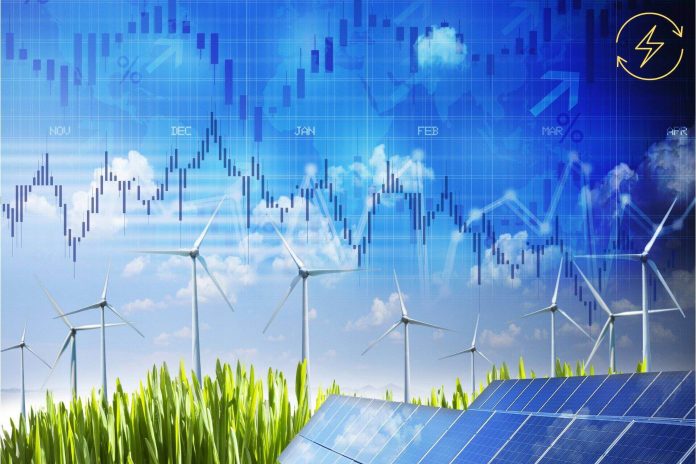For the first time since 2000, the potential of renewable energy in Croatia will enable an export balance in energy exchanges on interconnections this year. Also, 2023 will be a brilliant year for the green transition in Croatia and a year for accelerating the construction of renewable energy sources, primarily solar power plants and new wind farms, to consolidate our position as one of the drivers of renewable energy in the European Union. In this process, the key role of the transmission and distribution network in the energy transformation in Croatia must be emphasized: “without the network, there is no renewable energy or green transition.”
In the current global transition, Croatia, with its renewable energy resources and its potential for further exploitation, could become energy self-sufficient and fare better in the future than most EU countries.
Aware of the interest in understanding the evolution of electricity consumption and production, especially renewable energy, in Croatia and Europe, the importance of these technologies in combating climate change, and reinforcing our commitment to being current with statistical data in the electrical energy sector, we present a monthly report on electrical energy opportunities in the Croatian electrical energy system.
Electrical Energy Opportunities for the Period January – November 2023
The total electricity turnover in the electrical energy system in the eleven months of this year amounted to 23,836 GWh, of which the demand was 17,667 GWh, and the remaining 837 GWh was exported.

The total production of electricity at the threshold of power plants in Croatia amounted to 15,260 GWh, of which production from non-renewable sources was 4,712 GWh or 30.9%, and from renewable sources 10,548 GWh or 69.1%.
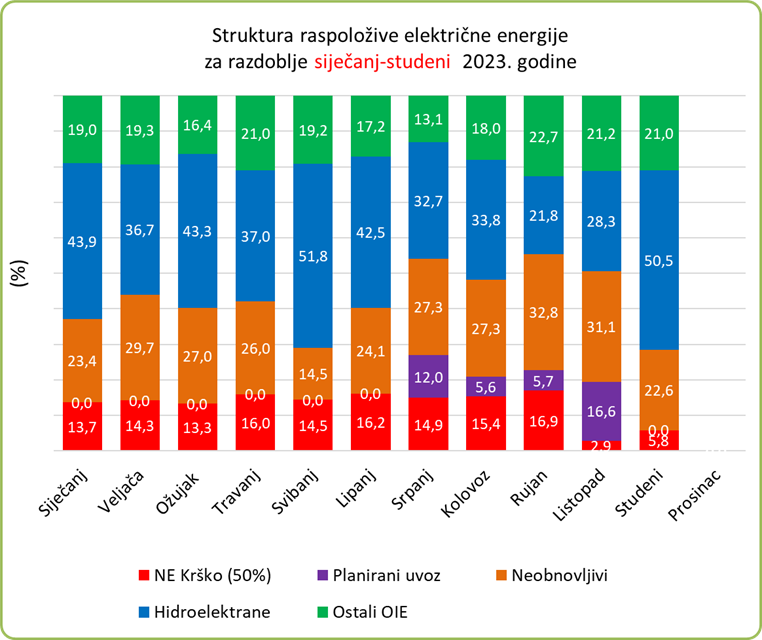
Croatia is in the top 5 countries in the EU with such a production structure, where 73.8% of the available energy is decarbonized for the first eleven months.
The total consumption of electricity amounted to 16,830 GWh, of which domestic consumption was 16,716 GWh, and the consumption of pumped-storage hydroelectric plants for water pumping was 114 GWh. The production of the Krško Nuclear Power Plant for the needs of Croatia was 2,407 GWh. This production could have been higher by 367 GWh if there had not been a failure in the primary part of the power plant from October 6 to November 17. The shortfall was compensated by imports and higher production of thermal power plants in October and higher production of hydroelectric power plants in November.
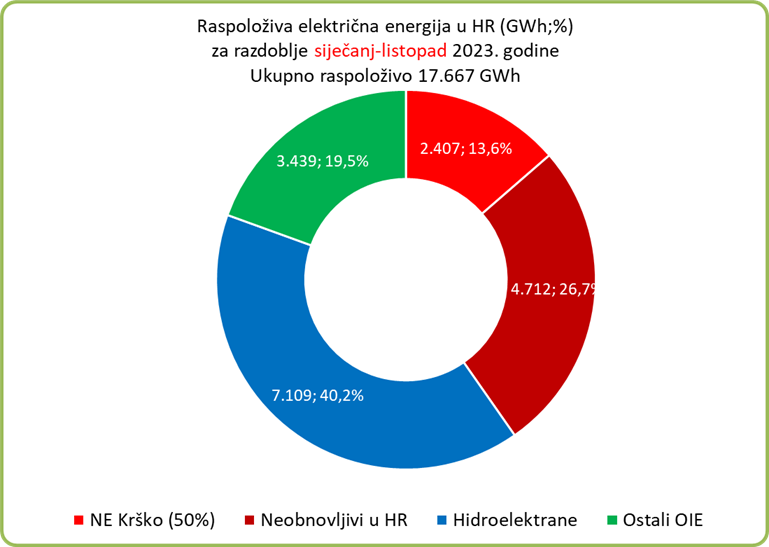
In terms of characteristic indicators, renewable sources contributed 59.7% to the available energy for the first eleven months of this year. Of this, hydroelectric power plants made up 40.2%, other renewable sources 19.5%, non-renewable sources 26.7%, and the Croatian part of the Krško Nuclear Power Plant 13.6%. It is expected that other renewable energy sources will exceed 20% of the available energy this year.
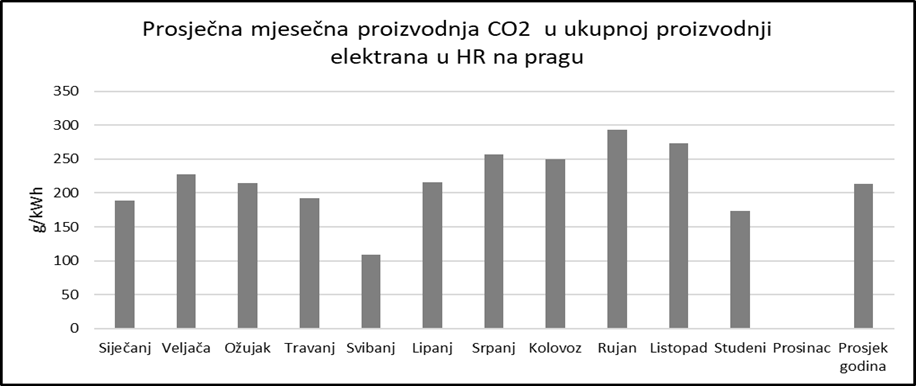
The average CO2 production in the total electricity production of power plants at the threshold for the first eleven months was 213 g/kWh, which classifies Croatia as a highly decarbonized country in the EU regarding electricity production.
Renewable Energy Sources Production
The total production of renewable energy sources (RES) in the first eleven months amounted to 10,548 GWh, and there was a discharge of accumulations compared to the beginning of the year amounting to 129 GWh, so the total productivity of RES was 10,419 GWh. This year, with average utilization factors in December, higher annual RES production of over 11 TWh (about 27 TWh of primary energy) is expected.
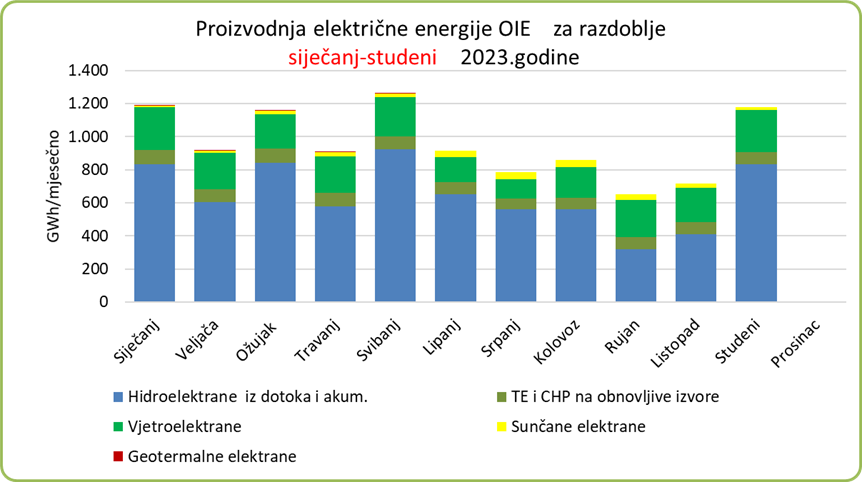
In the first eleven months of this year, compared to the first eleven months of last year, very favorable energy indicators have been achieved, which will also lead to positive economic indicators in the operations of energy participants, primarily HEP (Croatian Electricity Company).
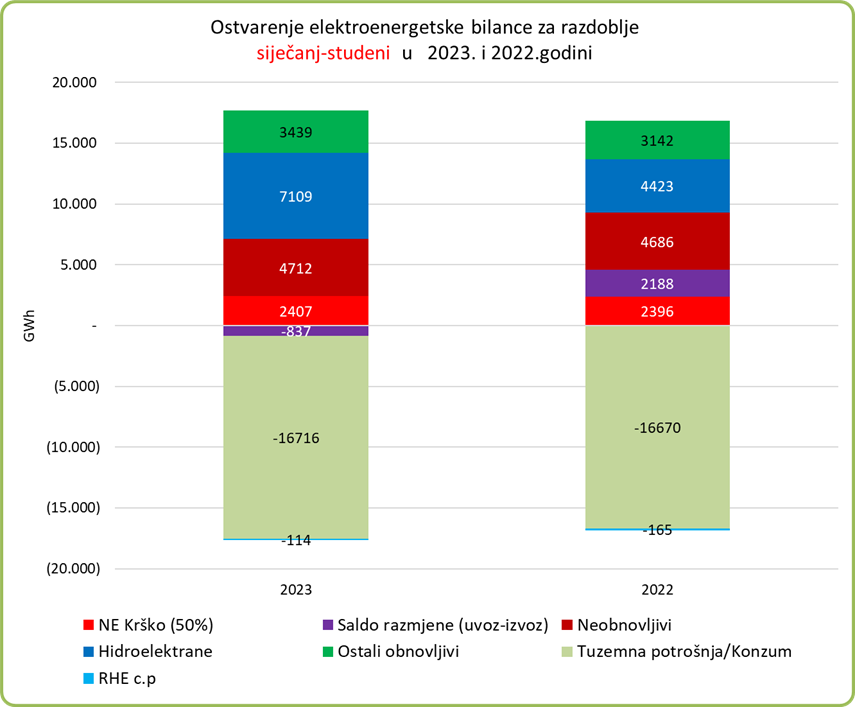
Despite the malfunction, the Croatian part of the Krško Nuclear Power Plant produced 11 GWh more. The production of renewable sources increased by 2,983 GWh, with a notable increase in hydroelectric power production by 2,686 GWh, wind power by 178 GWh, and solar power by 212 GWh. Non-renewable sources produced 26 GWh more, while the production of other renewable energy sources was 93 GWh less.
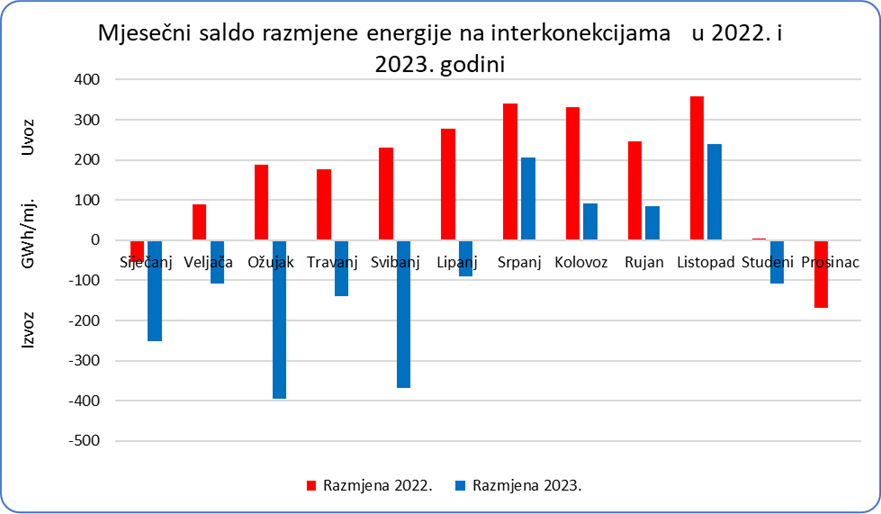
A net export of electricity of 837 GWh was achieved, while in the same period last year, there was a net import of 2,188 GWh. The difference is 3,025 GWh, which is economically excellent considering the market prices during the observed periods. In seven months of this year, there was a monthly net export, and in four months, there was an import of electricity.
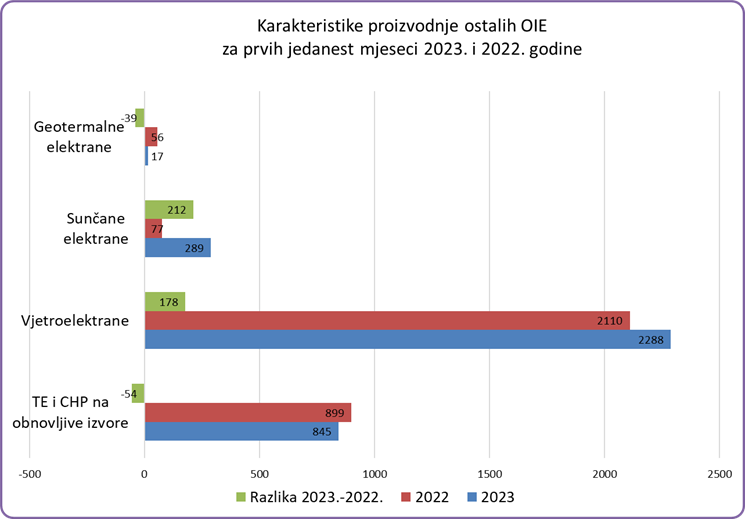
There is a significant increase in the production of solar power plants due to the commissioning of new production capacities (408 MW as of October 1st) – 212 GWh more compared to the same period last year, and good production from wind farms – 178 GWh more, along with a decrease in production from geothermal power plants.
Review of Energy Trends in November
Hydroelectric power plants played a dominant role in electricity production in November.
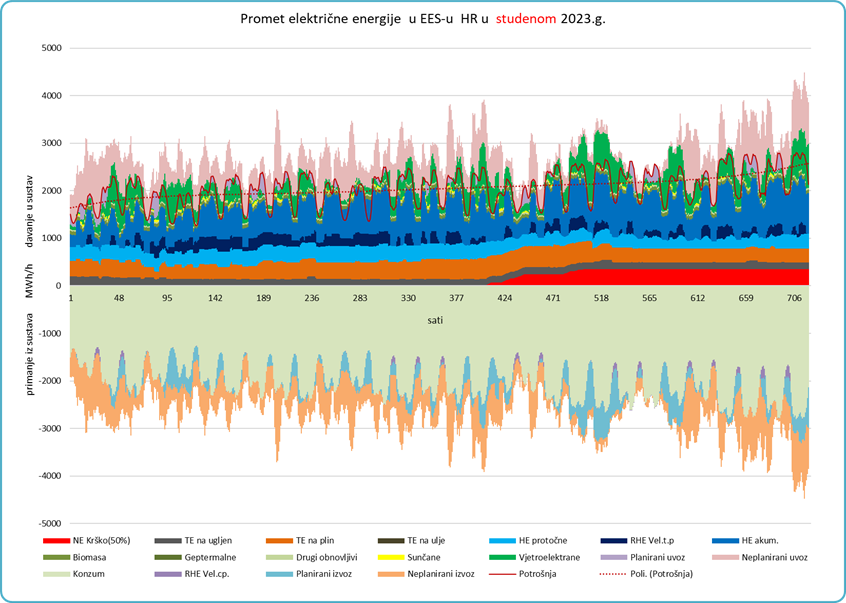
During the month, the Plomin Thermal Power Plant (TE Plomin) had reduced production (108 GWh) due to high production from hydroelectric power plants. The Krško Nuclear Power Plant (NE Krško) was out of operation until November 17th, producing 96 GWh in November, while its potential production should have been 250 GWh. This shortfall was also compensated by increased electricity production from hydroelectric power plants. The maximum daily production of wind farms was 18,612 MWh.
Renewable energy sources completely covered the electricity consumption for 41 hours in November and on a daily level during one day.
Production of Wind and Solar Power Plants in November
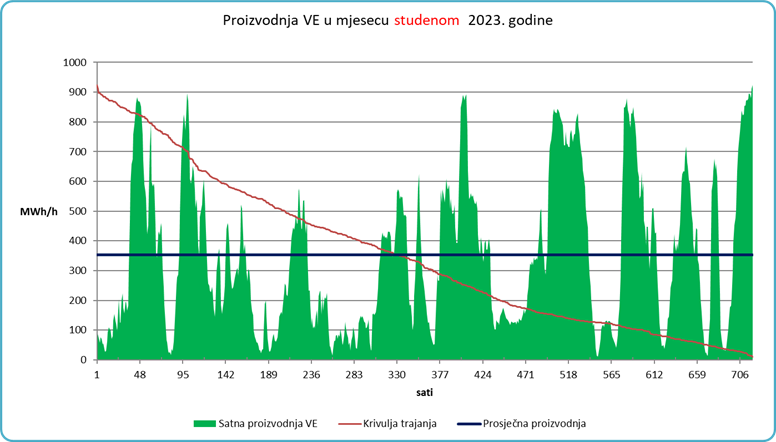
In November, the Bruvno Wind Farm (VE Bruvno) with a capacity of 45 MW entered trial operation, bringing the installed capacity of all wind farms to 1160.15 MW, while the approved capacity for grid connection is 1136.85 MW. The total production of wind farms in November amounted to 254,801 MWh, with a capacity utilization factor of 32.4%.
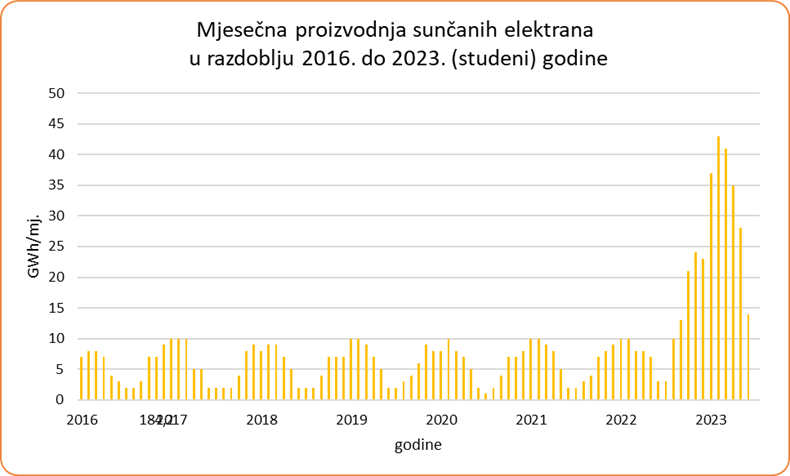
There is a significant increase in the production of solar power plants this year, with monthly (seasonal) fluctuations due to changes in solar irradiation. In the annual balance, 70% of the production of solar power plants is achieved in the period from April to September.
From January to November 2023, solar power plants produced 289 GWh of electrical energy. According to forecasts from December 1st, production with this technology will reach over 300 GWh in 2023, thus exceeding the production for the entire period from 2019 to 2022, which was 297 GWh.
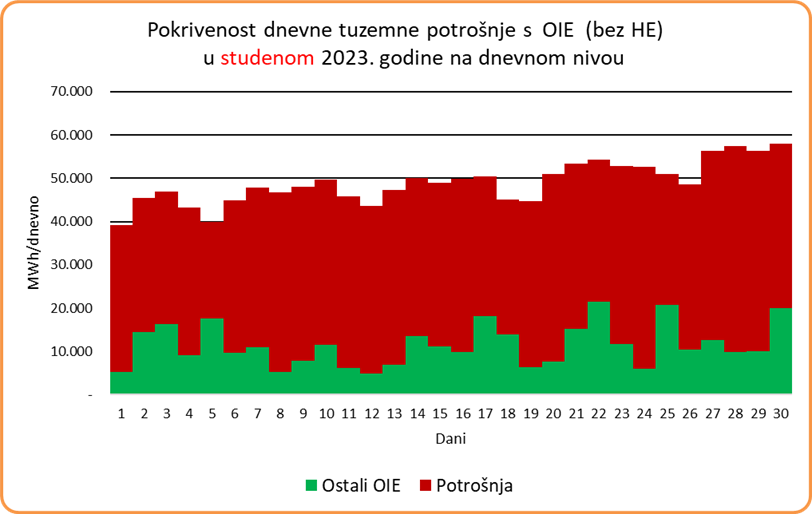
On a daily level, renewable energy sources (excluding large hydroelectric power plants) covered 44.1% of consumption on November 5th, meaning almost half of the electrical energy consumed that day came from renewable sources.
In the preparation of this report, publicly available data published on the websites of HEP, HOPS, ODS, HROTE, CROPEX, NE Krško, ENTSO, DZS, RTE France, RED Electrica, World Data, IEA, EEX, EPEX, and IRENA were used.
The analyses published in the monthly OIEH reports are made available to all those who wish to be informed about the operation and development of the Croatian electrical energy system. The quality and continuity of the service we provide in these analyses stem from a sustainable vision focused on the culture of informing about the work and development of renewable energy sources in our country.


